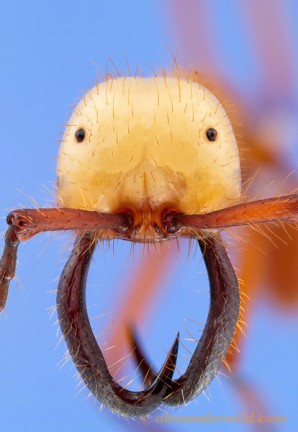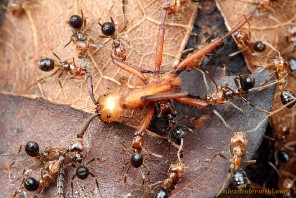Adaptations
Ants as Arthropods
Ants have an external skeleton that is made of chitin. The
exoskeleton is a muscle attachment site for the organism, provides
structural support and protection.
You can learn more about how ants work and their internal systems by
clicking here!

How does it fit into its niche?
Eciton hamatum has adapted by reducing its compound
eyes to a single facet. To compensate they have developed a
series complex pheromones to communicate with each other.
Eciton soldiers also have large mandibles that are hook
shaped that are specific to the genus Eciton. The waist
has two segments in it and the stinger development is very
developed. Look at the interesting adaptations of the poisonous
flower
Plumeria rubra (Frangipani).
 E. hamatum are also a very specialized
type of ant attacking specific types of prey unlike other
species that are generalized predators. The Eciton also
forage and emigrate above ground and form nests called bivouacs
in which the ants surrounds the brood and queen. To learn more
about migrating cycles click here!
E. hamatum are also a very specialized
type of ant attacking specific types of prey unlike other
species that are generalized predators. The Eciton also
forage and emigrate above ground and form nests called bivouacs
in which the ants surrounds the brood and queen. To learn more
about migrating cycles click here!

Since
the ant species Eciton hamatum is a nomadic ant colony, they must
make homes that they can travel with. To accomplish this these ants
have adaptations that enable them to make a home out of their
bodies! These ants have tarsal hooks at the ends of their legs that
allow them to hook onto each other to enable them to make long
chains of ants. This enables them to hang from logs and make a
hanging wall of ants that protects the brood and queen. These ball
shaped masses of ants are called bivouacs and serve as their
temporary home.

Another interesting adaptation that E. hamatum has evolved
to have is venom gland and stinging apparatus. You can check out
this cool adaptation by clicking here.
Another organism that lives in a colony and is poisonous is the
bacteria
Shigella sonnei click to learn more.